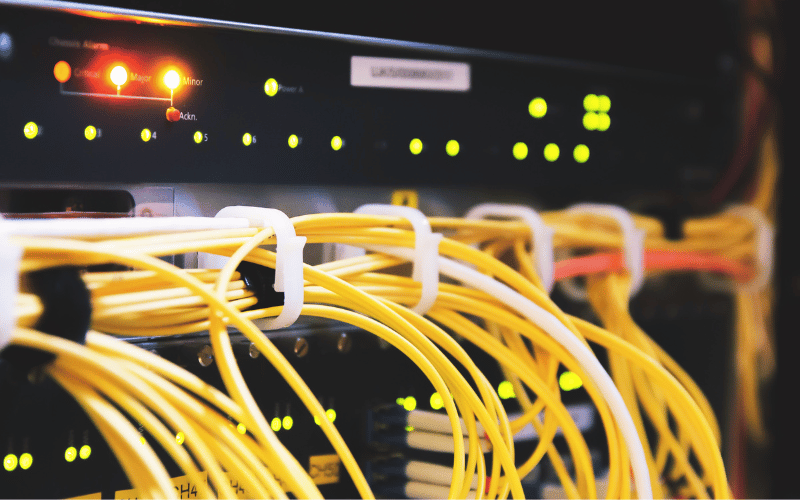How Does Wired Network Authentication Work?
How does wired network authentication work?
Wired network authentication is a process that verifies the identity of a device or user trying to access a network via a physical, wired connection, such as Ethernet. It is an essential part of network security, ensuring that only authorized devices or users can access the network resources. Wired network authentication typically involves the following steps:
- Physical Connection: The first step is to physically connect the device to the network using an Ethernet cable. This establishes the physical link between the device and the network switch or router.
- Link Layer Communication: Once the physical connection is established, the devices communicate at the link layer (Layer 2 of the OSI model). In most cases, Ethernet is used for this layer. This communication is essential for device discovery and initial communication with the network infrastructure.
- 802.1X Authentication: The most common method for wired network authentication is the use of the IEEE 802.1X standard. This standard provides a framework for port-based network access control. Here's how it works:
- Supplicant: The device seeking access (e.g., a computer or smartphone) is referred to as the supplicant. The supplicant initiates the authentication process when it connects to the network.
- Authenticator: The network switch or router that the device is connected to acts as the authenticator. It is responsible for controlling access to the network port and enforcing authentication policies.
- Authentication Server: An external server, often a Remote Authentication Dial-In User Service (RADIUS) server, is responsible for verifying the supplicant's identity. The authenticator communicates with the authentication server to make authentication decisions.
- Authentication Process:
- The supplicant sends an initial request to the authenticator, indicating that it wants access to the network.
- The authenticator responds with a request for the supplicant's credentials (e.g., username and password).
- The supplicant provides its credentials, which are typically in the form of a username and password.
- The authenticator forwards these credentials to the authentication server.
- The authentication server verifies the credentials. If they are valid, it sends an acceptance message to the authenticator. Otherwise, it sends a rejection message.
- Based on the response from the authentication server, the authenticator either grants or denies network access to the supplicant. If access is granted, the network port is opened, allowing the device to communicate on the network.
- Access Control: Once authenticated, the device is granted access to the network resources based on the policies defined by the network administrator. This may include access to specific servers, VLANs, or other network services.
- Session Management: The network may keep track of the authenticated session and monitor it for any unusual activity. If a session becomes inactive or violates network policies, it may be terminated.
Wired network authentication provides a robust method of controlling access to a network, ensuring that only authorized devices or users can connect and use network resources. It helps enhance security by preventing unauthorized access and protecting sensitive data on the network. Different organizations may use various authentication methods and protocols, but the 802.1X standard is one of the most widely adopted for wired network authentication.
What's the most secure method of wired network authentication?
The most secure method of wired network authentication typically involves using a combination of strong authentication protocols and security practices. While the specific choice of method may depend on your organization's needs, here are some elements that contribute to a highly secure wired network authentication system:
- IEEE 802.1X with EAP-TLS or EAP-PEAP: IEEE 802.1X is a widely accepted standard for network access control. The security of 802.1X authentication largely depends on the Extensible Authentication Protocol (EAP) method used. Two highly secure EAP methods are:
- EAP-TLS (Transport Layer Security): This method uses digital certificates to authenticate both the client and the authentication server. It is considered one of the most secure options because it ensures mutual authentication, making it difficult for attackers to impersonate either party.
- EAP-PEAP (Protected Extensible Authentication Protocol): PEAP is also a strong choice, as it provides secure authentication by encrypting the authentication process within a TLS tunnel. While it doesn't require client-side certificates like EAP-TLS, it still offers robust security.
- Network Access Control (NAC): Implementing a Network Access Control system adds an additional layer of security. NAC solutions can enforce security policies based on device health and compliance checks before granting network access. This helps ensure that only secure and properly configured devices are allowed on the network.
- Multi-Factor Authentication (MFA): Consider implementing multi-factor authentication as part of the wired network authentication process. In addition to something the user knows (e.g., a password), MFA requires something the user has (e.g., a smartphone for receiving authentication codes) or something the user is (e.g., biometric authentication). This significantly enhances security by adding an extra layer of verification.
- Strong Password Policies: If using username/password-based authentication, enforce strong password policies, including complex password requirements, regular password changes, and account lockout policies to protect against brute-force attacks.
- Regular Updates and Patch Management: Keep all network infrastructure components, including switches, routers, and authentication servers, up to date with the latest security patches and firmware updates to address known vulnerabilities.
- Network Segmentation: Segment your network into different zones or VLANs based on access requirements. This reduces the attack surface and limits lateral movement for potential intruders.
- Monitoring and Intrusion Detection: Implement network monitoring and intrusion detection systems to detect and respond to suspicious or unauthorized activities in real-time.
- Physical Security: Protect physical access to networking equipment and network ports. Unauthorized physical access can bypass many security measures.
- User Education and Training: Train users on security best practices, such as recognizing phishing attempts and protecting their login credentials.
- Regular Security Audits: Conduct regular security audits and penetration testing to identify vulnerabilities and weaknesses in your network authentication system.
It's important to note that security is a continuous process, and the most secure wired network authentication system should be part of a broader security strategy that includes proactive monitoring, incident response planning, and a commitment to staying current with emerging threats and security best practices. The choice of the "most secure" method may vary depending on your organization's specific needs and risk tolerance.
Are there any vulnerabilities with wired network authentication?
While wired network authentication is generally considered more secure than wireless authentication due to its physical nature and the use of protocols like IEEE 802.1X, it is not immune to vulnerabilities. Here are some potential vulnerabilities and security concerns associated with wired network authentication:
- Physical Access: One of the most significant vulnerabilities is physical access to network ports and infrastructure. An attacker with physical access to a network port can potentially bypass authentication by directly connecting to it or by using techniques like port stealing. To mitigate this risk, physical security measures, such as locked wiring closets and tamper-evident seals, are essential.
- Unauthorized Access: If an attacker obtains valid login credentials (e.g., through phishing, keylogging, or social engineering), they can gain access to the network even if strong authentication methods are in place. User education and multi-factor authentication can help mitigate this risk.
- Credential Theft: Passwords and credentials can be stolen if they are not adequately protected. Weak password policies, password reuse, and inadequate storage of credentials on devices are potential vulnerabilities. Strong password policies and secure storage practices are crucial.
- Man-in-the-Middle (MITM) Attacks: MITM attacks can occur if an attacker intercepts or manipulates the communication between the supplicant and the authentication server during the authentication process. Strong encryption and secure authentication methods, such as EAP-TLS, can help mitigate this risk.
- RADIUS Server Vulnerabilities: The RADIUS (Remote Authentication Dial-In User Service) server, commonly used in 802.1X authentication, can be a target for attacks. Vulnerabilities in the RADIUS server software or misconfigurations can be exploited by attackers. Regular updates and security audits of the RADIUS server are essential.
- Denial-of-Service (DoS) Attacks: Attackers can launch DoS attacks against the authentication infrastructure to disrupt network access. This can be mitigated through network redundancy, load balancing, and intrusion detection systems.
- Endpoint Security: The security of the endpoints (devices seeking network access) is critical. If an endpoint is compromised with malware or vulnerabilities, an attacker can gain access to the network after authentication. Network Access Control (NAC) systems can help assess endpoint health before granting access.
- Insider Threats: Authorized users with malicious intent can pose a significant threat. They may abuse their access to the network to steal data or launch attacks. Monitoring and access controls are important for detecting and mitigating insider threats.
- Weak Encryption: In cases where encryption is not adequately configured or is weak, data transmitted between the supplicant and the authentication server may be at risk. Using strong encryption protocols (e.g., TLS) is crucial for securing the authentication process.
- Credential Management: Managing and securely storing credentials on devices can be challenging. Weak credential management practices can lead to the compromise of sensitive information.
To mitigate these vulnerabilities, organizations should adopt a multi-layered security approach that includes physical security, strong authentication methods, regular security audits, user education, and continuous monitoring. Security measures should be regularly reviewed and updated to address emerging threats and vulnerabilities in wired network authentication systems.
How does wired network authentication manage guest access?
Managing guest access in a wired network typically involves implementing specific policies and technologies to allow temporary and limited access to visitors or users who do not have regular network credentials. Here's how wired network authentication can manage guest access:
- Isolation: Guest access is usually isolated from the main network to prevent guests from accessing sensitive resources and potentially compromising security. This isolation can be achieved through network segmentation or VLANs (Virtual Local Area Networks). Guests are placed in a separate VLAN, which restricts their access to a predefined subset of network resources.
- Captive Portal: A common method for providing guest access is through a captive portal. When a guest connects to the network, they are redirected to a web page where they must log in or accept the network's terms and conditions. Once they've authenticated or accepted the terms, they are granted access to the network. Captive portals are often used in public places like hotels, airports, and coffee shops.
- Temporary Credentials: Instead of using regular network credentials, guests are typically provided with temporary credentials, such as a username and password or a time-limited access code. These credentials are generated for a limited duration and are often automatically revoked after a specified period, ensuring that guest access is temporary.
- Limited Access: Guest access is usually restricted to essential internet services like web browsing and email. Access to internal network resources, file shares, and other sensitive data is typically prohibited.
- Bandwidth Management: Guest access can be subject to bandwidth limitations to prevent guests from consuming excessive network resources and degrading the network's performance for regular users.
- Authentication Methods: Various authentication methods can be used for guest access, such as:
- Open Authentication: In some cases, guest networks are entirely open without any authentication required. While this is the most straightforward approach, it offers the least security and is not recommended for sensitive environments.
- Pre-Shared Key (PSK): A shared key can be provided to guests for access. However, this method can be less secure if the key is not changed regularly, as anyone with the key can access the network.
- Voucher Systems: Guests can be issued vouchers or access codes with predefined expiration times. These codes are entered when connecting to the network.
- SMS Authentication: Guests can receive a one-time code via SMS for authentication.
- Self-Registration: Guests may be allowed to self-register by providing basic information, which can be used for tracking and auditing purposes.
- Guest Network Management: Network administrators should have tools and policies in place for managing guest access, including the ability to monitor guest activity, revoke guest credentials, and troubleshoot connectivity issues.
- Logging and Auditing: It's essential to maintain logs of guest access activities for security and compliance purposes. These logs can be used to trace any suspicious or unauthorized activities back to specific guest users.
- Security Measures: Even though guest access is typically isolated, security measures like intrusion detection, firewall rules, and content filtering can be applied to the guest network to enhance security and protect against potential threats.
Managing guest access in a wired network involves finding a balance between providing convenience for visitors and maintaining the security of the organization's network. The specific approach and technologies used for guest access may vary depending on the organization's policies and security requirements.








